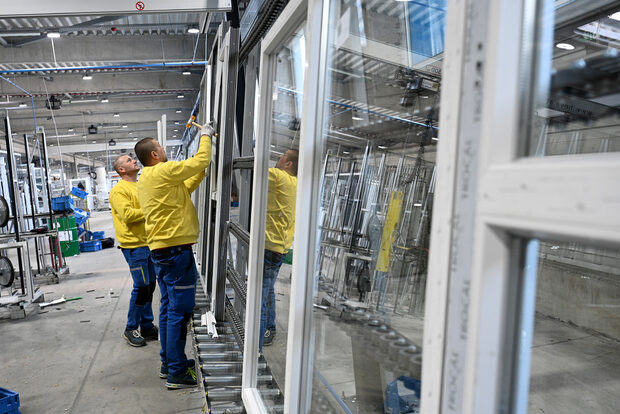There are quite a few cliches about the unreliability of statistics, but the one you will read about below seems to perfectly justify most of those. After an under-the-radar revision published last week, the Bulgarian National Statistical Institute (NSI) revised the data for the country's gross domestic product (GDP) growth for 2021 from 132.7 billion levs up to 139 billion levs. The major revision that covers some of the figures for 2020 and also data for the first two quarters of 2022 was published by the NSI on 19 October without explanation.
This is not some minor miscalculation. A comparison with data published in March shows that the NSI now assumes that the economy in 2021 has grown not by 4.2% but by 7.6%. It also emerges that the decline in 2020, which was marked by the first two waves of the Covid-19 pandemic, was slightly smaller than previously assumed - -4% instead of -4.4%. There are also revisions for the current data from the first half of 2022 and significant shifts in the weight of the different components that constitute GDP.
In principle, revisions are not uncommon - initial flash estimates and preliminary GDP data are made with many assumptions, and as more data come in, they may undergo changes. A deviation of over 6.2 billion levs, or 3 percentage points, however, is quite significant and certainly raises questions about the reliability and quality of economic statistics. GDP is one of the most important macroeconomic indicators, being used not only as a measure of growth but also for a variety of comparisons, including those embedded in legal and regulatory documents.
Therefore, its radically different value, as well as the reasons and factors that led to the change, should be clearly communicated to the public. However, the NSI made the revision rather furtively - it was announced in the institution's calendar but no press release or explanations accompanied it.
The missing 6 billion levs in 2021.Comparing the new data with the old, using the different methods applied by the NSI to calculate GDP makes it possible to see at least partly where the discrepancy comes from. The sectoral data show that the largest part of the revision - up by 4.5 billion levs - falls in the "Trade, repair of motor vehicles and motorcycles; transport, storage and post; hotels and restaurants" group. This is obviously quite broad, so it is difficult to ascertain exactly where the large discrepancy comes from. There are also big increases in the financial sector (1.8 billion levs) and agriculture (1.1 billion levs), while the new figure for the industrial sector is 1 billion levs lower than before.
If one looks at the end-use method, it appears that change is coming along almost all sectors. Consumption has been underestimated by 2 billion levs, with virtually the entire revision attributable to household consumption. In gross capital formation the revision is up by 3.3 billion levs, with most of it coming not from change in investment but from the change in inventories. In its latest macro forecast released a few days ago, the Bulgarian National Bank attributed it to the stockpiling of raw materials and supplies due to their expected appreciation. Now, the new NSI data shows that this process has started earlier - as early as the second half of 2021.
The data on trade in goods and services has also been revised upwards, with exports (1.6 billion levs) exceeding imports (+0.85 billion levs). So the revision in net exports also makes a positive contribution to growth.
The effect on 2022
A purely mechanical increase in GDP for 2021 should have lowered the annual growth figures in 2022. However, in practice this is not very noticeable, as the revision also covers data from the first two quarters of the current year. There, change is not as drastic, but it is not negligible either - nominal GDP for the first half of the year is up from the previous estimate by over 1.2 billion levs to 73 billion levs . This is again almost entirely due to an increase in household consumption, as well as more exports and imports than originally reported.
The final result is a bit controversial - according to the seasonally adjusted data, which enters the official international statistics and are also used by Eurostat, the growth in early 2022 was in fact even faster than previously reported. In the first quarter, the number was revised from 4.2% to 5.3%, and in the second quarter from 4% to 4.8%. However, if one looks at the unadjusted data, the revision leads to slightly lower growth for the same periods.
All calculations from scratch
The most significant result of the big revision is that the values of all the indicators, involving different ratios to GDP, may in practice be quite different from what analysts and official institutions have assumed so far. For example, when the initial figures of 137.74 billion levs were announced in March, NSI estimated that this corresponded to 19,268 levs (or $11,645) per capita. However, if the new higher figure is taken into account, as well as the smaller population according to the last year's census, a figure of around 21,300 levs emerges.Other important ratios such as debt to GDP mechanically get lower. The budget deficit for 2021 should also shrink from the 4.1% of GDP reported previously to around 3.9%. The picture is also changing in international comparisons - for example, Bulgaria's growth in 2021 is no longer below the EU average but, on the contrary, ranks among the highest in the bloc.
The new numbers also mean that all analyses and forecasts based on them have to be modified. For example, significantly higher growth at the end of 2021 is likely to automatically translate into lower year-on-year growth at the end of this year. Higher and longer accumulated business inventories are also an indicator that could imply lower growth in the near term until the backlog of goods is sold or stored raw materials are incorporated into finished goods. This is perhaps the most significant problem from the unusually large revision, as businesses base their planning and budgeting precisely on expectations of next year's growth and other indicators.
There are quite a few cliches about the unreliability of statistics, but the one you will read about below seems to perfectly justify most of those. After an under-the-radar revision published last week, the Bulgarian National Statistical Institute (NSI) revised the data for the country's gross domestic product (GDP) growth for 2021 from 132.7 billion levs up to 139 billion levs. The major revision that covers some of the figures for 2020 and also data for the first two quarters of 2022 was published by the NSI on 19 October without explanation.
This is not some minor miscalculation. A comparison with data published in March shows that the NSI now assumes that the economy in 2021 has grown not by 4.2% but by 7.6%. It also emerges that the decline in 2020, which was marked by the first two waves of the Covid-19 pandemic, was slightly smaller than previously assumed - -4% instead of -4.4%. There are also revisions for the current data from the first half of 2022 and significant shifts in the weight of the different components that constitute GDP.












